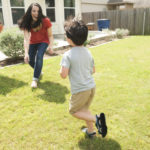Baby-wearing keeps your child kissably close–and the benefits can go beyond quick cuddles. Carriers may reduce infant crying and improve mom’s mood. Baby-wearing can also make it easier to breastfeed. To keep your child safe, however, follow these tips.
1. Find the right fit for the baby and your lifestyle.
There are many carrier styles. Do you want to wear your baby against your chest or on your back? Facing in or out? Age is a factor; the carrier must properly support the baby’s developing neck and hip muscles. Always check the packaging for weight and age recommendations. For information on sling standards, visit the U.S. Consumer Product Safety Commission.
2. Do your research.
Unlike car seats, there are no regulations governing carriers. Search the internet for product recalls. Message boards and Facebook pages for new parents can provide helpful tips. If a friend offers to give you her old model, be cautious. Look for pulled stitches or broken fasteners.
3. Read the directions thoroughly.
Never buy or use a carrier if there is no manual, either in print or online. Watch videos or, if available, take a class.
4. Don’t use the carrier as a sleeping device.
We all want our children to be calm and quiet in public places. However, carriers keep your baby close so you can interact with smiles, kisses and coos. Fabric can easily cover a sleeping baby’s face and cause breathing difficulties. Always make sure your baby’s face is visible.
5. Be mindful about your activities.
Wearing extra weight on your chest or back can affect your balance. Moreover, you might not see the toys or the dog at your feet from your viewpoint over the carrier. Resist the urge to text and walk. It might sound simplistic, but if you stumble, you might fall on your baby and injury the child or yourself.
For more information, speak with your child’s health care provider or visit the Baby Carrier Industry Alliance.
Allen Friedland, M.D., FACP, FAAP, is a primary care physician and section chief of Medicine-Pediatrics and director of the Medicine-Pediatrics residency program.




